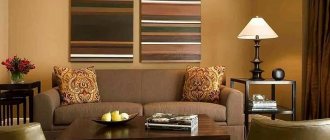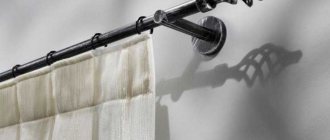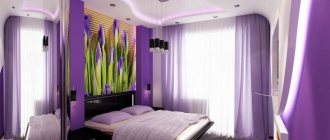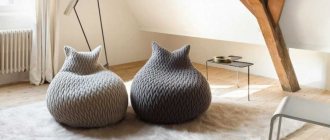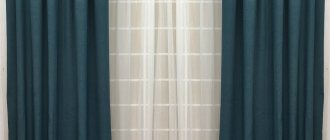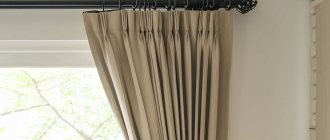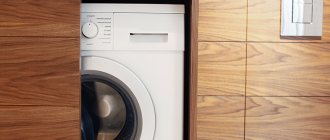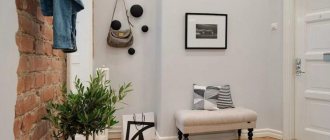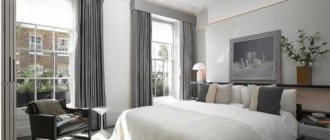Curtains with a lambrequin in the living room are a decorative element that emphasizes the window opening.
Curtains decorated with lambrequins can give a room a luxurious and rich look. With the right choice of type of lambrequins, such a design can not only complement the room, but also emphasize its style and become the highlight of the interior.
Photo gallery more than 40 photos
Amazingly beautiful openwork lambrequins - photo.
What are lambrequins?
Craftsmen have always used beautiful folds and carved patterns to decorate windows. A panel with lace inserts was attached to a baguette to give the composition more grace.
Openwork lambrequins are not just decoration, they are a functional element that covers the fastening of curtains. Swirl strip strips do a great job of filling the top of the wall near the ceiling. Carved products made from practical materials do not need frequent washing. It is enough to sometimes wipe them with a slightly damp sponge. The felt surface is vacuumed about once a month.
How windows are designed
The lace design of the window opening is the result of design experiments. The elegance of patterns in the Art Nouveau style, the curls of Vologda and Romanian lace gave the openwork lambrequins a lot of original elements.
The idea of adding soft linings to curtains has been known since Baroque times. Carved wooden baguettes became popular in the second half of the 19th century. Openwork strips for the cornice, carved felt overlays, and a bandeau lambrequin are modern elements.
Designers of curtain compositions regularly offer fresh ideas in addition to traditional solutions. Original window decoration solutions can make the interior of a country house or city apartment inimitable. Combined lambrequins are the most attractive; they combine elements of different complexity. Parts with soft folds - swags, molds, interceptions - are attached to the rigid base.
Important criteria for selecting finished products
Not so long ago, multi-layer curtains returned to fashion, so the production of openwork lambrequins was launched.
- the length and width of the decorative element depends on the format of the window opening, the purpose of the room and its area (for a small kitchen, a carved triangle or an elegant strip is suitable);
- to visually expand the space of a bedroom or nursery, you need a cornice that occupies the entire wall;
- for the hall or living room the most expensive decor is selected, for other rooms something more modest is suitable;
- the color may differ from the main palette; a contrasting shade or a slightly darker shade of curtains and accessories for them will do;
- the format of the decoration and the complexity of the ornament should emphasize the style;
- You shouldn’t overload the windows with decor; it’s unreasonable for the patterns to dazzle your eyes.
When choosing carved decor, you should think about the practicality of what cleaning method the curtains need with the addition of a new module. The easiest way to clean a hard plank is with a sponge and household products. Soft lambrequins can only be vacuumed.
How to determine size
Parameters play a very important role when choosing a lambrequin. After all, if you choose a model that is too heavy and bulky, it will darken the room and cover most of the curtains. And too small and narrow decor simply will not be clearly visible.
The very first thing you need to do when choosing a decoration for curtains is to measure the parameters of the room: length, width and height.
In rooms with low ceilings, a cornice strip 15 centimeters high is suitable. It has an openwork and light appearance that will easily decorate a small room.
Ordinary apartments have standard parameters, in this case the range of models to choose from is very wide. It is recommended to select options with a height of 30-40 centimeters.
As for rooms with high ceilings, openwork decor with a height of 50 centimeters or more will fit well into them.
First way. How to make an openwork lambrequin with your own hands
No matter how complex the pattern of the decorative overlay may be, anyone who has the skills to work with fabrics can do it. There is a detailed video tutorial on how to make an openwork lambrequin with your own hands (at the top of the article).
If you have the ability, the easiest way is to copy a sketch from a beautiful illustration. You can take a ready-made template, enlarge it, print it on a printer, or make a stencil. This will be the pattern for the openwork lambrequins, as in the picture.
To work, you will need thick fabric that matches the format of the carved element; scraps from curtains will do. It will be placed with the front side facing the room, so check where the back side is. On this side, the base is sealed with a special lining (dublerin, non-woven fabric, preferably the same color). This backing will stick after ironing without steam.
A stencil or pattern is applied to the compacted workpiece to mark the perforations - the holes that form the pattern. It is difficult to cut through lined fabric with scissors without damaging it. With synthetics, it is convenient to use a household electrical appliance for burning patterns with the smallest nozzle.
A solid ribbon with a curly loose edge can be slightly scorched with matches - synthetic threads shrink from the fire. The finished openwork lambrequin can be attached with Velcro to the cornice.
Openwork lambrequins with laser processing
Materials with loose edges must be carefully overlaid or overcast with your own hands. The process takes a lot of time, and not all seamstresses can process the edges manually. It is much easier to take bandeau fabric (synthetic felt), this is a suitable base for a hard lambrequin with laser processing (perforation).
Most studios have a laser cutting machine. It makes it much easier to make a carved design on any material. Openwork overlays made of synthetic felt are made according to preliminary markings, then perforation is performed with a cutter.
How to make a lambrequin from cord and wire
A beautiful decoration for curtains can be made without fabric. For an openwork lambrequin made of cord, you will need steel or aluminum wire, which is tightly wrapped around a silky braid.
Textile decor is offered in specialized stores for handicrafts:
- silk tassels and cords;
- fringed braid;
- large beads, crystals;
- border with tassels, bells;
- satin ribbons for fixing curtains.
All this is used as a basis for wire structures or applications on a rigid lambrequin.
First you need to draw a template, maintaining mirror symmetry. A wire should be laid out along it, tightly wrapped with a cord, which is glued to “liquid nails” at the ends.
At the junction of several flexible elements, the cords are hemmed from the inside out with thin fishing line or matching silk thread. You can add tassels, pebbles or beads to the finished product, as in the photographs.
Recommendations for washing and ironing
Over time, the curtain decoration begins to get dirty, stains appear on it and dust settles. To ensure that the product retains its original appearance, it should be washed and ironed from time to time.
Tips for properly washing and ironing decor are presented below:
- items made of silk and wool are washed by hand; to do this, the fabric is placed in a soap solution, then rinsed in clean water;
- polyester and tulle, on the contrary, are best machine washed in a gentle cycle;
- It is not recommended to wash velvet and chenille decor with your own hands; it is better to take it to the dry cleaner;
- After washing, the lambrequin should be ironed: the iron is set to a delicate setting, the fabric itself is carefully ironed in places of folds.
Now clean and ironed jewelry will become even more beautiful and can last longer.
Types of lambrequins
Elegant lambrequins with openwork patterns differ in the manufacturing method:
- modular or shaped products;
- strip and strip lambrequins (with alternating identical patterns along the entire length).
Modular
Working with combined decorations can be difficult, but the finished curtain composition will impress with its beauty. Modular lambrequins differ from roll ones in that they are formed from individual elements that can be arranged in different ways.
Openwork modules are arranged in different ways:
- horizontally (in the center of the composition, along the entire length of the cornice);
- vertically (at the edges, mirror-symmetrical), in the middle (like a single tulle decoration).
Solid lambrequins with an expressive pattern are attached to small hooks of the cornice, like any other element of the curtain composition.
Plank
Tape or strip lambrequins cover the multi-level fastening of tulle and curtains. This decor is not complicated in design. It resembles a wallpaper border, but is much tougher and features a beautiful openwork pattern.
Applications
In some cases, a volumetric element in the center of the composition is appropriate on the cornice. You can create entire compositions from multi-colored parts. Volumetric appliqué also looks good in the corners if the curtains are positioned symmetrically.
Configurations of soft lambrequins
Upholstered products can be decorated in different ways using draperies. This allows you to create curly folds of different shapes. This design suits classic interiors well and creates a slightly theatrical atmosphere.
Folds of the mold
For such decoration, the windows must have sufficient width. Silk fabrics are the best choice for such drapery. It looks like a symmetrical cascade, laid out in longitudinal folds converging in the middle part.
Fairy lights
This design is also called a swag. It forms sagging semicircular elements with draping folds in the upper area. Attach the garland to the pipe in the middle part or on the sides.
Swags can form a symmetrical pattern or be on only one side. In addition to single-color options, designs in contrasting colors are also possible.
Frill assemblies
This is one of the variations of swag. The name comes from the fact that the folds here are similar to a French frill. In this case, the drapery is done from the edges, without affecting the middle part of the opening. As a result, the folds emphasize the edges of the opening.
Reversible option
Typically, such a design is created from a pair of lambrequins. The rigid canopy is installed in the usual way, and the second element is thrown over the cornice. The design looks good when decorated with a tubular cornice. She resembles a vine curling around him.
Drapery like a tie
This design option is in many ways similar to frill. But there are also differences: the “tie” has a characteristic knot. The pattern is formed by longitudinal folds.
Cascading drapery
This is a draped textile fabric mounted in the side of the opening. The length of the cascade can be different (it is selected in accordance with the height of the window).
To obtain a zigzag design of the opening, the lambrequin is sewn with a lining of a contrasting tone. It is possible to create a cascade of two or more lambrequins.
Materials
The sample you like in the picture can be made with your own hands if you have a suitable base. For openwork lambrequins, you need a hard material - thick fabric, decorative plywood or a metal rod entwined with a silk cord.
Felt
Compressed materials made from synthetic fibers are an ideal basis for carved decor. Do not heat-treat (burning or laser cutting) natural felt; natural wool has a specific smell.
Only a synthetic analogue is used (polyester or nylon), it can be cut with a stationery knife or carpenter's cutter. It has a high density, so it is not necessary to place the loose edge, it is better to lightly burn it.
Cords
Cord fringe, tiebacks and braid are used not only as accessories for finishing and supporting curtains. They are used to make beautiful openwork on wire.
Software
Some types of openwork strips are made from new materials. The software resembles velvet paper or cardboard with a matte velor surface.
Tree
Wooden baguette strip is an expensive basis for luxury curtains. High-quality laminated plywood will help reduce the cost of window opening design. Apply an openwork stencil, transfer the design to the workpiece and cut it out with a jigsaw.
Chanzelize
Double-sided curtain fabric is a new generation synthetic textile resembling satin. Smooth, pleasant to the touch, the new product with a French name is suitable for glossy lambrequins with perforations.
Combination of lambrequins with different interior styles
Lambrequins can adequately decorate any interior. The main thing is to choose the right material, style, correctly combine textures and use decorative elements.
Contemporary
This style is often called "luxurious simplicity". Its main features: laconic layout, comfort, design integrity, functionality, clear forms, smooth surfaces, a minimum of accessories, the use of built-in and modular furniture.
To decorate a window in a kitchen in contemporary style, it is best to use a simple rigid lambrequin in combination with blinds. Frills, folds, fringe and puffs will be completely inappropriate in this option. As for the color scheme of the lambrequin, it should be in harmony with the overall interior. It is advisable to choose light shades or white.
Provence
One of the most cozy and warm kitchen interior styles. It is perfect for lovers of elegant simplicity and rustic romanticism. Natural materials are used to furnish the premises: wood, ceramics, clay, stone. To decorate a window, you should choose a soft lambrequin made of light, light fabric. The use of ruffles, folds, frills, and bows is encouraged. You can combine a lambrequin with curtains, tulle, curtains.
Baroque
A style that is distinguished by the greatest pomp and luxury. To recreate it, you need a room with a high ceiling, light and spacious. Expensive natural materials should predominate in the interior; the use of synthetics should be excluded.
As for the decor of kitchen windows in the Baroque style, an excellent option would be to use luxurious “jabot” lambrequins, falling down in soft folds. The use of fringe and lush tassels is also encouraged.
It is important that the window openings are large and high enough. You should combine lambrequins with heavy curtains, or choose expensive tulle to match them
Empire style
Arranging such an interior in the kitchen is not an easy task. This requires a fairly spacious room and a large budget. This style is associated with luxury and wealth, and this means that only natural and expensive materials can be used in decoration. The set should be made of natural wood; porcelain tiles or stone are suitable for finishing the floor.
Particular attention should be paid to decorative elements: you can arrange heavy candelabra, use elegant gold-colored fittings, hang a large chandelier. The lambrequin must match such splendor
It can be soft, hard and combined, the main thing is to use only expensive fabrics, silk tassels, fringe, scallops. The color scheme should be chosen saturated.
Country
A cozy rustic style that will appeal to people tired of the noise and rhythm of the metropolis. When arranging such a kitchen, you should not chase luxury, the main thing is to make it comfortable and convenient.
Maximum stylization of the room as a rustic kitchen is encouraged: the ceiling can be decorated with beams, bunches of garlic and onions can be hung on the walls, clay jugs can be placed on the shelves, etc.
When decorating a window, it is best to choose a soft lambrequin made of light fabric that falls in soft folds. It should be combined with the same simple curtains.
Art Deco
This style is suitable for sophisticated people who follow every fashion trend. A kitchen in this style should be luxurious and at the same time laconic. Decorative elements should be used in very measured doses.
When choosing a set, it is best to give preference to simple forms with glossy and mirror surfaces. In the decoration of the room you can use natural or artificial stone, metal, wood, glass. To decorate a window, a rigid lambrequin is suitable, to which you need to choose a translucent light (preferably white) tulle.
High tech
A strict and modern style, chosen by people who keep up with the times. The kitchen should be laconic and as functional as possible. A rigid straight lambrequin can be combined with blinds, but there is no place for different curtains, tulle and curtains in such a room. The color scheme should be restrained, a combination of contrasting shades is possible.
Interior design ideas
Complex compositions require a thoughtful solution. Expensive openwork lambrequins are impractical and not suitable for every room, so not every choice is justified.
Kitchen
In this room, functionality comes first, practicality is more important than aesthetics. An openwork baguette strip made of washable material is quite appropriate in the kitchen interior, without any additions.
Living room
In the reception room you can afford more luxury than in other rooms. Design experiments with openwork inserts on combined lambrequins are appropriate. They go well with soft draperies (svagami, crossovers, molds).
Bedroom
The romantic atmosphere in the privacy room will be emphasized by a spectacular lambrequin with 2-3 carved elements on the sides.
Children's
In this room, nothing should distract the child’s attention when going to bed. It is better to limit yourself to a laconic satin ribbon “chanzelize” on the cornice or symmetrical felt details.
What selection rules exist?
There are three basic rules for choosing this accessory for your home. The first thing you always pay attention to is the color of the product. It is very important to choose the right shade that will harmoniously combine with the main color scheme of the room. Experts advise that this decorative element dominate the room. By the way, if we talk about whether the lambrequin should be combined with the cornice in color, then it is also not necessary to select exactly the same color, it is enough that they have the same tone.
An openwork lambrequin can match the color of the curtains
Another option is to play on the contrast between the color of the lambrequin and the tone of the curtains, but here it is important to take into account the style of the interior. If we are talking about classic design, then the combination of brown and gold or beige and dark colors looks very harmonious. The only thing you should consider is that there is at least one accessory in the room that has the same color as the lambrequin.
Contrasting openwork lambrequin perfectly complements the details
It is important to choose the correct shape of the lambrequin. In this case, one important rule is that the smaller the room, the simpler the pattern on the lambrequin should be. If you work hard, today you can find lambrequins that will harmoniously combine even with a room designed in a minimalist style.
Don't forget about the size of the product. The width of the part always depends on how large the window dimensions are. The rule in this case is very simple - the smaller the width of the window, the simpler the lambrequin should be and the smaller the window area it should occupy.
Of course, an openwork lambrequin is one of the most popular and reliable options to make your room more stylish and sophisticated.
But when purchasing this decorative element, it is very important to consider for what specific room it is being purchased. If you are purchasing curtains with a lambrequin for the kitchen, then it is better to look at the photo of the kitchen interior in advance. They clearly show that such a decorative element is used only in the room where a very good ventilation system is installed.
Openwork lambrequin can be selected according to the shape of the window
To avoid mistakes, you should initially consult with an experienced expert in this matter and only after that start decorating your own premises. Otherwise, the result may be negative, and the owner of the premises will receive a design that is completely different from what he expected.
The lambrequin must be selected depending on the type of room. It can be made according to an individual project.
Stylistic options
The elegance of openwork lambrequins can update a thoughtful style solution. They look great in laconic minimalism, extravagant art deco, luxurious baroque.
Classic
Multi-layer curtains add their own flavor to an elite interior with precise proportions. In this case, openwork inserts made of dense fabric can become the basic component of window decor.
Modern
General urbanization and new technologies are the main idea of hi-tech, loft or urban minimalism. There is a tendency to simplify textile compositions. They do not always have room for openwork additions, with the exception of rolled lambrequins. They complement the curtains with scallops, as in the photo.
Modern
There is a distinction between modern style and modernism, which reigned in art at the beginning of the twentieth century. Modern in translation means “modern”. The era of decadence (decadence) gave birth to the Art Nouveau style - with asymmetry and grace of lines. The characteristic “modern” design looks good on a wire lambrequin or a wooden insert with handmade carvings.
Styles
Initially, curtain decorations were created for baroque and rococo interiors. However, modern manufacturers offer a wide selection of products that are suitable not only for a classic room, but also for a more minimalist design.
The main styles in which lambrequins are made:
- Baroque. A style that perfectly fits luxurious curtains made of expensive fabrics. Actually, the varied decoration of curtains began and developed precisely during the period of the European culture of the same name.
- Rococo. Similar to Baroque in its decoration and splendor of the premises. Decoration of curtains can be asymmetrical and consist of semi-swags. The decor itself is recommended to choose light shades, decorated with gilded fringe.
- Retro. The decor should not be too sophisticated; preference should be given to fabrics with rustic patterns: flowers, fruits, geometric patterns. It is also recommended to use buffs.
- Shabby chic. The artificially aged style is characterized by bright canvases with appliqué in the form of ribbon embroidery.
- Modern. The use of curtain decoration is not very welcome in this style. But if you set this goal, then you should choose openwork options with patterns made in a technical or urban theme, which decorate, for example, Roman blinds.
- High tech. The lambrequin should be made only of rigid fabric and have a minimalistic appearance.
The right decor will not only complement the look of the curtains, but can also become a real decoration of the interior in a certain style.
Lambrequin design
To create something original, you will have to review a lot of other examples of window design with carved patterns. As a basis, you can take various style solutions, lambrequins with monograms, floral patterns, and curls.
It doesn’t matter whether the pattern is complex or simple, it’s worth thinking through all the steps - from the sketch to the method of fixation. The slightest inaccuracy or the wrong decision about how best to hang a finished element can ruin the results of your work.
With flowers
A rigid lambrequin is often complemented with overhead elements. You can sew voluminous flowers made of shiny or matte fabrics, attached to an openwork lambrequin, yourself.
Ready-made leaves and artificial flower petals are suitable. They are attached on top of drawn or embroidered outlines. It is better to cover the joints with beads and ribbon knots.
Two-color
The easiest way to complement a two-color combination is to apply an openwork ribbon to the surface of the baguette. It is better to combine the light part with the darker part, so the pattern will be even more expressive.
Bright shades do not go well with a pastel palette. Shades that are close in degree of saturation are recommended. Dark or contrasting edging should be in harmony with other elements of the fabric.
Asymmetric
Among the most interesting ideas for the design of balcony windows are asymmetrical lambrequins. Most often these are multi-layer compositions that combine hard and soft parts plus an openwork module on the opposite side of the passage to the loggia.
With rhinestones and on one side
It is important to observe moderation when decorating a room with shiny or shimmering additions to a patterned lambrequin. It is better to place pebbles or beads in the form of an edging of an openwork ribbon attached to the cornice.
You should not sew rhinestones all over the surface, it may look tasteless.
On a window with a window or in a passage with a balcony door, it is easy to touch the lambrequin part with your hand. Single-sided inserts with patterned elements are suitable.
Types and options
Photographs of lambrequins fitted into the interior of the hall clearly show the variety of their varieties, configurations and textures. There are several main types:
The classic includes tops made from a piece of fabric, assembled in the form of beautifully flowing spectacular ruffles: molds, frills, bells, bells, bows, folds, ties, swags and flips. The fixing elements are decorative satin ribbons, openwork braid, elegant hairpins and clips.
Soft models are made using a technology similar to classic ones, but from light, airy and translucent fabrics. Most often they are made in monochrome and combined with curtains.
A bandeau is a rigid and dense strip of fabric treated with “sealants” (double-lined, non-woven fabric) and fixed to a solid base. Such decorations are more suitable for minimalist interiors.
By experimenting with the edges of the product, which can be straight, oblique, curly, rounded or openwork, the room is given extravagance and luxury.
An openwork lambrequin, contrasting with light light tulle, has become trendy recently. It is made using a laser, resulting in the finest ornaments and intricate designs made of hard or semi-rigid material. This top is attached to the curtain using an adhesive backing or special textile fasteners.
A puff is a piece of fabric, the shape of which is given by a certain lacing. With the help of a rope, the decoration also clings to the curtain. This type of top is usually compact and does not prevent sunlight from entering the room, which helps to visually increase the space.
Combined models are distinguished by a combination of several types in one multi-level composition with alternating flowing, dense and openwork elements with various types of fastening and decoration.
Combination with curtains
Variability in window design does not imply rigid boundaries. Bold experiments are acceptable to find those duets that are in harmony with the openwork details of the lambrequins.
Drapes and curtains
The classic duet “curtain + tulle” or thick fabric for hall curtains with a veil can be complemented with a lambrequin with openwork modules in a contrasting color. These details are perceived much more interesting in artificial light; during the day, the drawing looks more modest.
A beautiful curtain does not need to be complemented by a day/night curtain, with the exception of the bedroom. An ornate wire overlay entwined with silk cords will suit a classic baguette with a spectacular curtain.
Roller blinds
The lifting type of curtain fits perfectly into the design of a small kitchen. In this duet, a cornice ribbon with lace perforation, reminiscent of the cutwork embroidery technique, is appropriate.
Roman curtains
The Italian style of kitchen curtains is considered very common. Roman blinds go well with rigid “bandeaus” or a patterned baguette strip, as in the photo.
Popular types of curtains
Curtains, curtains, drapes... There are many options. You can, of course, choose a simple option - tulle fabric and curtains made of opaque dense or loose fabric. But if you want variety and style, you should find out what types of curtains exist and find the right option for yourself.
French curtains
French curtains are a thick silk fabric that is laced multiple times along its entire length. With the help of such cords, these curtains can, if desired, be lifted and collected at the eaves. You might have seen curtains like these in the theater - the same burgundy or snow-white curtains gathered along the entire height. The class of curtains is lifting, i.e. they do not move apart to the sides as we are used to, but rise up.
Fabrics from which French curtains are made:
- silk;
- veil;
- tulle;
- batiste;
- organza.
The material can be smooth or with an embossed pattern, the main thing is that the fabric lays in smooth soft folds
Austrian curtains
Austrian curtains are similar to French ones. They are also laced, falling in folds and also liftable, the difference is that Austrian curtains are laced only at the bottom edge, which is why when lifting Austrian curtains only the lower part is folded, while the upper part remains smooth.
Austrian curtains fit well into a classic or French interior
Roman curtains
Roman blinds are similar to fabric blinds (there are horizontal rigid slats inside the fabric folds). When lifting such curtains, they fold into identical horizontal and even folds. Linen, velvet, velor and tulle are used to sew Roman blinds. When unfolded, patterns and designs look great on Roman blinds, because the fabric is smooth due to the wooden slats.
Roman blinds are a very convenient option for the kitchen
This photo shows an interesting version of Roman blinds complete with curtains
Japanese curtains
Japanese curtains are a kind of vertical blinds-partitions or, as they are also called, screen or panel. Japanese curtains are based on a sheet of fabric and two wooden slats at the bottom and top of the curtain. Oriental style, high-tech and minimalism are true friends of such curtains.
Japanese curtains in an oriental style kitchen interior
Roller blinds
Roller blinds are a canvas made of thick fabric, most often cotton or linen, which is wound over the top edge onto a metal pipe to which it is attached. And a weighting in the form of a rack is attached to the bottom edge.
Roller blinds in the kitchen in a modern style
Curtains with lambrequin
Curtains with a lambrequin are similar to classic sliding curtains. Lambrequin is a transverse drapery made of dense fabric with flounces, folds, and tassels decorating the upper part of the window opening. Curtains with a lambrequin are made in different styles - from simple, close to rustic curtains, to luxurious, rich decoration. Look at the photo for different options for curtains with a lambrequin in the kitchen interior.
Crossed curtains
Crossed curtains are one of the most unusual and sophisticated types of curtains, despite their simplicity. Such curtains are made from two sheets of fabric, which are connected along the top edge, and then diverge downwards to different sides of the window. Crossed curtains are permanently attached to a rail above the window or thrown over a cornice (they can even be a single piece of fabric).
Crossed curtains look beautiful in contrasting colors
Pleated curtains
Pleated curtains are made from pleated fabric, and from a distance they look like blinds. This beautiful and soft fabric looks good in combination with straight, long floor-length curtains and traditional drapery fabrics.
Pleated curtains fit well on small windows
Non-standard window shapes
Private houses differ from city apartments in their original layout and non-standard window openings. Instead of curtain rods, brackets, suction cups, and Velcro are sometimes used. They can ruin the entire aesthetics of the window. They have to be covered with patterned lambrequins.
Bay window
The most difficult thing is to choose a design for alternating bay windows. An example in the photo is the author's design of the hall curtains with patterned felt overlays under the cornice.
Arch
Many architects claim that arched windows are the most beautiful, but they are the most difficult to decorate with tulle. A simple way is to fix the curtain with small brackets along the arch line, hiding the fastening with a lambrequin or openwork felt module.
A rigid gang for a non-standard window is attached to the ceiling cornice; there may be suction cups or Velcro underneath it, which is better to hide.
For two windows
The ornate decor for two openings should be mirror-symmetrical or identical in design. The duo looks good, where curtains with identically shaped tiebacks on different sides are complemented by vertical patterned elements.
It is important to be selective when choosing an original design, having good taste. A selection of illustrations in the interior gives a general idea of the use of this type of decor; there may be other options.
Types of lambrequins by type of fastening
The method of attaching curtain decorations may vary depending on the design of the curtains, as well as the desires and capabilities of the residents themselves.
There are the following types of decorative fastening:
- loops and ties, which are bows, ribbons or cords;
- eyelets, presented in the form of rings made of various materials, differ in different colors and sizes;
- curtain tape that will securely attach the decor to the cornice using glue or Velcro.
To install a structure consisting of decorated curtains and tulle, it is recommended to choose a plastic cornice with several sections.

